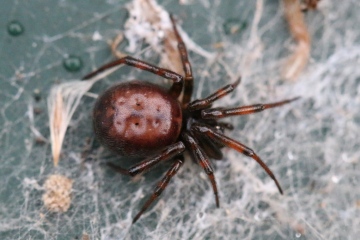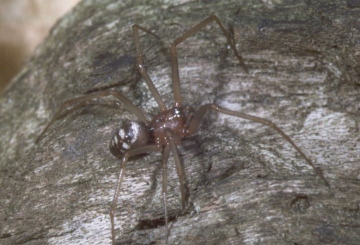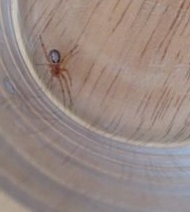False Widow Spiders
|
There are about 670 different species of spider occurring in Britain. Britain has no dangerous spiders. For authorative information on the toxicity of spiders Worldwide see Ed Nieuwenhuys's link on the demystification of the toxicity of spiders Of the spiders commonly found in houses or gardens, quite a few have a pattern or are dark, and Zygiella x-notata, Metellina species, Amaurobius species and Araneus diadematus garden spiders are frequently being mistaken for possible 'false widow' spiders and REPEATEDLY WRONGLY REPORTED IN THE MEDIA AS POISONOUS FALSE WIDOW SPIDERS. There are a number of Steatoda species found in Britain, all so-called 'false widow' spiders. False widow spiders do not make nests. Each individual makes a scaffold web with which it catches prey (various insects etc). Three are possible in or near buildings, Steatoda bipunctata (very widespread, probably occurring in every house, outhouse and building in the country, completely harmless to humans), Steatoda grossa (widespread and sometimes very frequent in the southwest, but becomes much scarcer further north and east, but in the last few years seems to be increasing) and Steatoda nobilis, the one which gets the press for biting humans (originally confined to the south coast, now increasingly turning up elsewhere in southern England). Steatoda nobilis has on occasions been responsible for bites, and Steatoda grossa is also known to be able to pierce human skin, even though many of the cases publicized for this are almost certainly due to another cause, and there are a few other spiders capable of piercing human skin. The media hype about 'false widows' (by which presumably Steatoda nobilis is meant) is beyond reason and irresponsible. The current distribution and information on the spider look at the Summary page. Steatoda nobilis is widespread and numerous along much of the south coast, has been established in the Southend area of Essex since at least 1990, and in more recent years had spread widely and become much more numerous in England as far north as Norfolk and also south Wales. Everybody in the coastal counties of Southern England has had lots of them in their house and garden for many years, whether they have been aware of this or not. They are now one of our commonest southern house and garden spiders. The fact that harm caused by them is very rare should tell you something about how dangerous they really are. As Evan Jones has pointed out on the forum, cars, electricity, walking along the pavement (with all those small irregularities), hot water, eating food and choking are really all much more dangerous, as are other people, who may be carrying harmful pathogenic viruses and bacteria. In addition to this, most of the supposed scare stories reported in the media are based on nonsense and cases where what is being reported has not been caused by any spider at all. Generally one should avoid handling the spiders. Trying to exterminate the spider is unlikely to succeed, since others will move in from the general area. The Spider Recording Scheme is an entirely voluntary organisation whose interest is in recording spiders, and cannot help with their removal. |
Steatoda bipunctata © Tim Hodge Steatoda grossa © Peter Harvey Steatoda nobilis © Edwin Silvester |